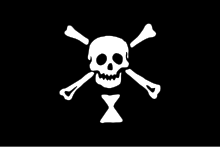Emanuel Wynn[a] (fl. 1700) was a French pirate of the 17th century who is often considered the first pirate to fly the Jolly Roger.

History edit
British Admiralty Records, in the Public Records Office in the UK show, in a report dated 18 July 1700, that HMS Poole, a 32-gun fifth-rate frigate[1] commanded by Captain John Cranby, engaged Wynn's ship off the Cape Verde islands. Cranby chased Wynn into a cove at Brava Island[b] where Wynn was able to hold out. Cranby enlisted the assistance of Portuguese soldiers, but thanks to their delay in attacking, Wynn slipped out of the harbor and escaped.[2]
Wynn's Jolly Roger Flag edit
Most historians agree that Cranby's journal is the first witness account of a black Jolly Roger used aboard ship,[3] which Cranby described as "a sable ensign with cross bones, a death's head, and an hour glass" (the quotation is from Earle, Pirate Wars, p. 154) or "A Sable Flag with a White Death's Head and Crossed Bones in the Fly."[4] Wynne is believed to be the first pirate to fly the now familiar form of the jolly roger.[5] His flag, showing the distinctive skull and crossbones motif, was augmented with another common pirate symbol: an hourglass, meant to signify to his prey that their time was running out and only by timely surrender could they evade death.[6] There were no other reports at the time of pirates using similar flags aboard ship (though red and other versions had been used by buccaneers during campaigns while ashore)[7] but within 15 years the skull and crossbones design and its many variants would become the standard flag of Golden Age pirates.[8]
See also edit
- Bartholomew Roberts, who was known to have flown not just one but several different Jolly Roger flags.
Further reading edit
- Fox, E. T. "Jolly Rogers: the True History of Pirate Flags."
Notes edit
References edit
- ^ "British Fifth Rate ship 'Poole' (1696)". threedecks.org. Retrieved 14 December 2018.
- ^ Earle, Peter (2005). The Pirate Wars. New York: Macmillan. pp. 153–154. ISBN 9780312335793. Retrieved 14 December 2018.
- ^ Sherry, Frank (1986). Raiders and rebels: the golden age of piracy. New York: Quill. pp. 92–93. ISBN 9780688075156. Retrieved 29 November 2017.
- ^ Grey, Charles (1933). Pirates of the eastern seas (1618-1723): a lurid page of history. London: S. Low, Marston & co., ltd. p. 17. Retrieved 26 June 2017.
- ^ Marley, David F. (2012). Daily Life of Pirates. Santa Barbara CA: ABC-CLIO. p. 181. ISBN 9780313395642. Retrieved 14 December 2018.
- ^ Pelkey, Jamin (2017). The Semiotics of X: Chiasmus, Cognition, and Extreme Body Memory. New York: Bloomsbury Publishing. p. 86. ISBN 9781474273855. Retrieved 14 December 2018.
- ^ Little, Benerson (2016). The Golden Age of Piracy: The Truth Behind Pirate Myths. New York: Skyhorse Publishing, Inc. ISBN 9781510713048. Retrieved 14 December 2018.
- ^ Kuhn, Gabriel (2009). Life Under the Jolly Roger: Reflections on Golden Age Piracy. Oakland CA: PM Press. ISBN 9781604862799. Retrieved 14 December 2018.[permanent dead link]